Nutrient supply of medicinal plants
Author: Éva Zámboriné Németh
Role of nutrients in plant physiological processes
Nutrients taking part in metabolism, structural constitution and physiological processes are most commonly grouped according to their concentrations necessary for the plant. This, however, does not mean that the importance of any mineral depends on its quantity, because their roles are very different and variable, the majority of nutrients is playing role in several, even independent life processes. As it is not our goal to present the basic knowledge on plant nutrients, we only summarize and repeat the most important facts which are necessary for the understanding of the following sections on specialities of medicinal plants.
Below there is an overview provided about the minerals which usually are subjects of nutrient supply during the cultivation.
1. Macro-elements are present in the plant tissues at a concentration of 10 -1-10-2 % on the average.
Their roles in plant life are usually well known, their presence in plant body is essential. In each culture, the proper supply of the plants with these elements is unavoidable. Usually, even a slight undernutrition (lack) is already observable in form of typical syndromes.
1.1. Constitutional elements, taking part primarily in tissue construction
-
Nitrogen (N): basic constituent of amino acids, proteins, enzymes, nucleic acids, alkaloids, indispensable for growth
-
Phosphorous (P): constituent of phospholipids, membranes, nucleotides, essential part of compounds taking part in energy transport
-
Potassium (K): has a role in water metabolism, regulates turgescent state of cells, osmotic processes, increases resistance
-
Sulphur (S): constituent of amino acids, proteins, enzymes, disuphie bridges stabilize macromolecules, takes part in photosynthetic electron transport
1.2. Functional elements, taking part primarily in metabolic processes
-
Calcium (Ca): stabilizes cell membranes, has a role in electron and ion transports, regulates cell division, functioning of some enzymes
-
Magnesium (Mg): central atom of chlorophyll, constituent and activator of enzymes, has a role in pH regulation
-
Iron (Fe): takes part in photosynthetic electron transport, synthesis of chlorophyll and proteins
-
Sodium (Na): has a role in osmotic processes, water household
-
Chlorine (Cl): takes part in photosynthesis
This grouping is to take in large and as basic direction, as the majority of constitutional elements have a role also in metabolic processes. For example potassium is regulating among others the opening of stomata and takes a role as central atom of some enzymes while sulphur may be considered as biologically active molecule of plant drugs, etc.
2. Microelements are present in the plant tissues at a concentration of 10 -3-10-5 % on the average.
The necessary amount of microelements for healthy plant development is usually less known than that of the macroelements and may be a more species-specific one. Lack symptoms are detectable only after a long term and severe (acute) undersupply. Absorption potential is in tight connection with soil properties, its pH and water content. Essential micro elements are e.g.:
-
Silicon (Si): has a role in metabolism most likely through synergistic effects with other elements
-
Boron (B): it has a role in development of meristems, growth, fertilisation, synthesis of carbohydrates
-
Manganese (Mn): takes part in photosynthesis and respiration processes
-
Zinc (Zn): constituent of enzymes, most important in nitrogen metabolism
-
Molybdenum (Mo): constituent of enzymes, most important in nitrogen metabolism
-
Copper (Cu): it has a role in photosynthesis, in protein and carbohydrate metabolism
-
Cobalt (Co): it has a role in several enzymatic reactions
It has been observed, that interestingly, the essential elements have mostly smaller atomic volume and not a high atomic mass. This phenomenon proved to be an advantageous feature during evolution.
We also have to mention the elements of adverse effects. In recent times, more and more attention is paid to the heavy metals because their concentration is increasing in some areas in the soil due to intensive industrial activity and traffic. They may be toxic for the plants even in a concentration as 2-20 mg/kg. In Europe, the most abundantly detected heavy metals are cadmium (Cd), chromium (Cr), mercury (Hg) and lead (Pb). Heavy metals may destroy photosynthetic electron transport, respiration chain, protein biosynthesis and enzymatic functions.
The elements –based on their variable chemical and physical characteristics – can be bound to soil particles by different strength, thus are available for the plants in unequal concentrations. Nitrogen and sulphur are the elements which can be most easily mobilized, but therefore they can be washed out most easily from the soil, too. On the other side, phosphorous, potassium, magnesium or boron, copper, manganese are bound strongly and stored in the soil for long.
If the plant is not able to get the optimal amount of the necessary elements, it is usually observable by special lack syndromes. In general, plant metabolism starts to change already before the visual appearance of these syndromes, the problem presents itself only in latent form. The growth of shoots and roots is slowing down, development of flowers is dragging on, fertilization and fruit setting is weak. Permanent and/or high degree of lack of different elements presents itself already in form of the lack syndromes in a visible form. Some of these syndromes are general for many species and elements (e.g. yellow discoloration of leaves, falling down of leaves, colourless fruits, etc.) but some others are characteristic only for the target elements. While the lack of nitrogen causes principally yellow colouration and fall of the elderly leaves, the lack of magnesium may induce yellow spots on the younger leaves.
Symptoms like scorching of the leaves, brownish and yellowish leaf edge may reflect lack of potassium but scorched spots on various fruits may show the lack of calcium. In order to carry out an optimal nutrition of the crop, we have to be aware of the fact, that not only the absolute lack of different elements but also a relative lack of them compared to other elements may induce symptoms and degradations. An excess supply of calcium may –for example- inhibit proper uptake of potassium and magnesium.
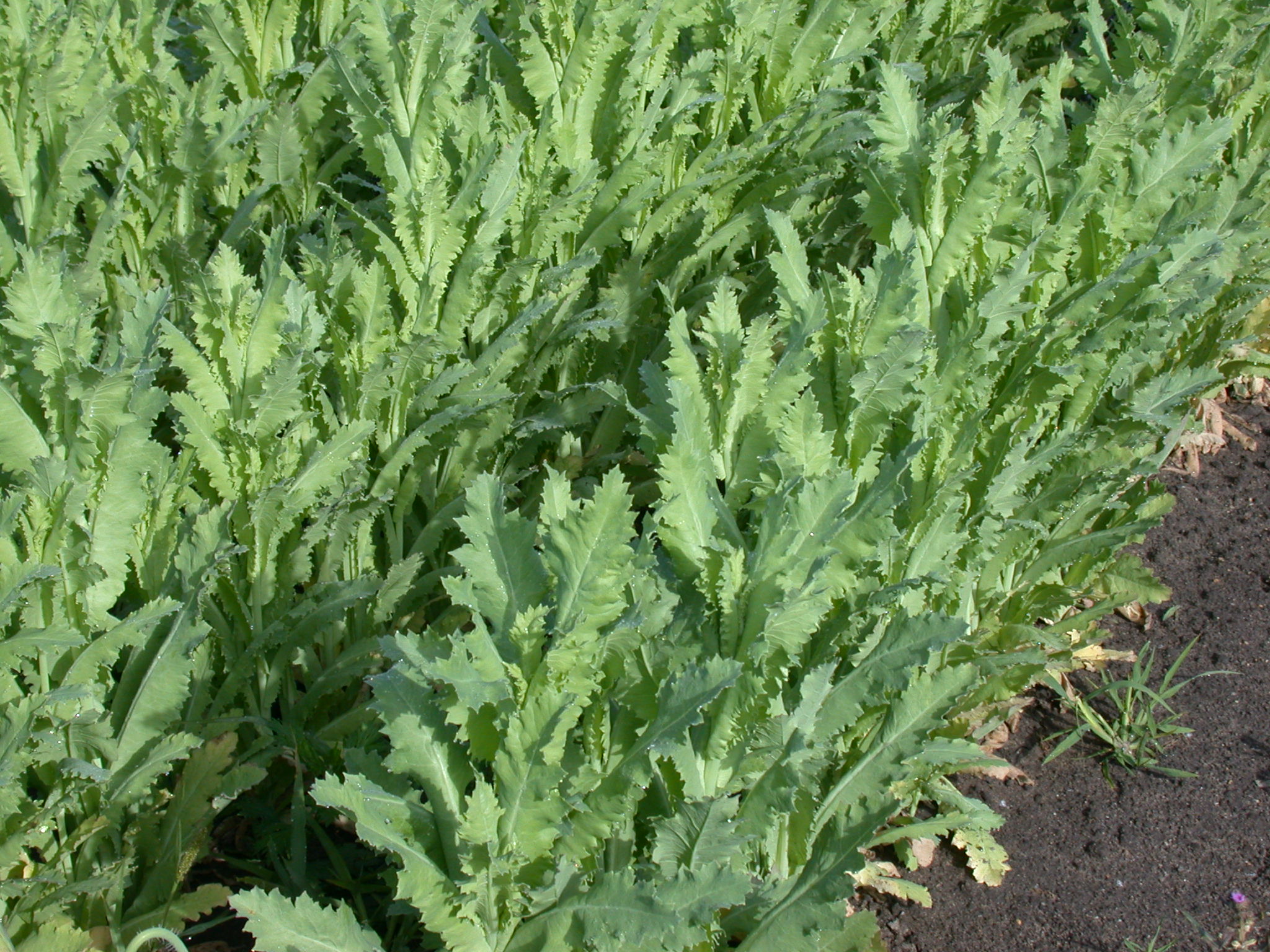
Poppy plants lacking in nitrogen
It is also known, that not only a low amount of nutrient but also their excess supply may induce toxicity, and can be dangerous. Overdosage of nitrogen manifests itself in large, deep green leaf system, but fewer flowers are developing. Ripening process is slowing down and the tissues of the plant became looser, which may result in a decreased tolerance against pests and diseases but also against abiotic factors. Overdosage is dangerous not only for the plant but reaches the consumers too, as it may contribute to a toxic accumulation level of nitrates in the human body. A further threat is that the high amounts of overdosed fertilizers may be washed out into the soil, into the natural waters and polluting the environment in large regions.
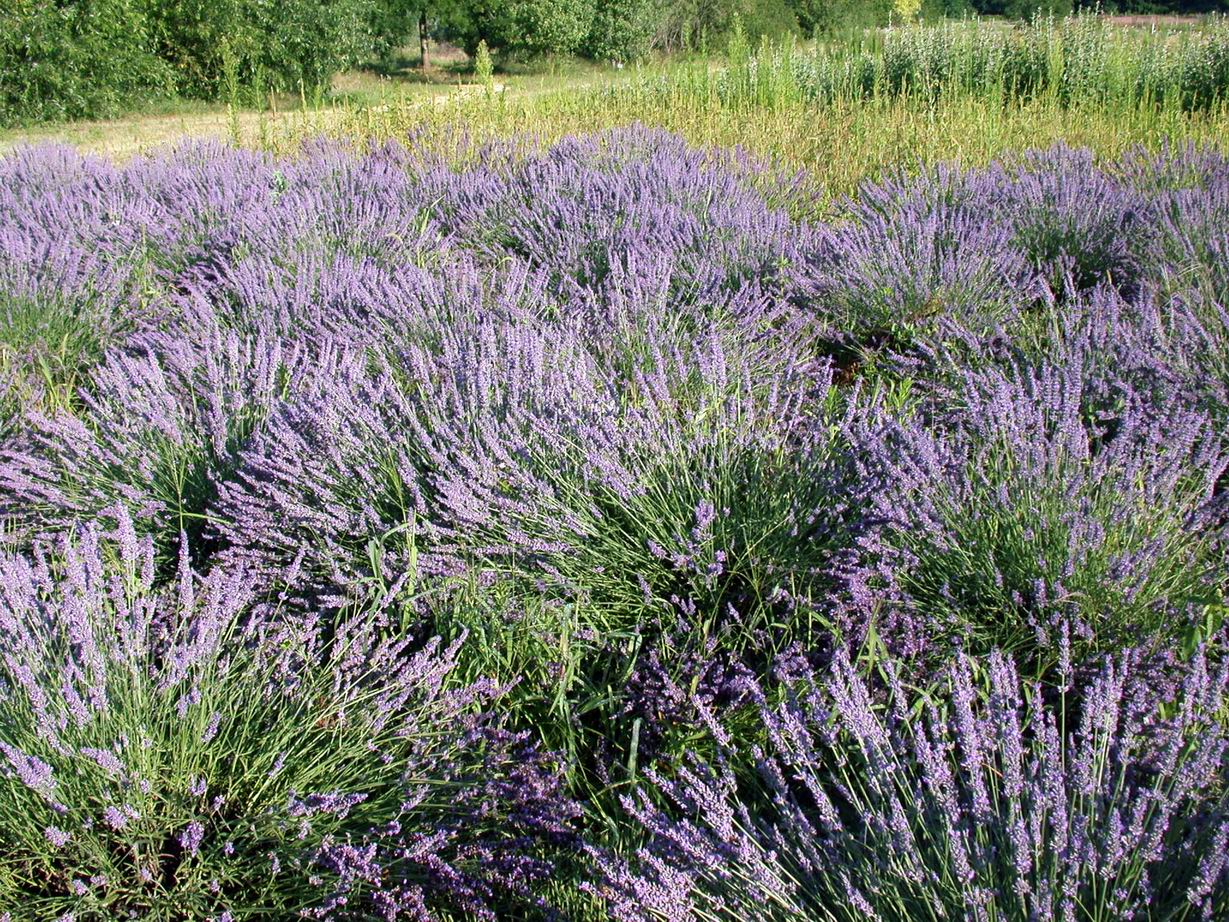
Loose bushes of lavender due to overdosage of nitrogen fertilizer
Basic principles of nutrient supply in integrated medicinal plant production
In medicinal plant production it is desirable –similarly to other branches of horticulture – to follow the principles of the integrated cultivation. A prerequisite is a minimal load to the environment and maintenance –or even improvement, if possible- of the soil fertility. During nutrient supply we have to focus on the product quality too, by this way promoting the health of the consumers, furthermore, the economically most advantageous solution should be chosen. Cultivation method should correspond to the geographical, natural circumstances of the area, fertilizers should be applied in optimal quantity and at suitable time according to the needs of the target crop. The GACP guideline, puts down –among others- that all types of fertilizers should be applied sparingly, in harmony with the needs of the culture, avoiding the hazard of washing out the chemicals into the soil water. Each organic manure shall be composted appropriately. In enterprises where procedures of the up-to-date quality assurance management are applied, basic numbers and data on nutrient supply and fertilization are among the necessary documents. An example for this documentation is provided in the table constructed and required by the Hungarian Agricultural Ministry (Figure 6.9.) gyogy6.9a.xls.
It is known, that the connection between the supply of the plants by nutrients and –as result of it- the biomass production is not linear but moreover a function close to the optimum one. By increasing dosages of mineral nutrients– after an initial so-called “dilution” phase- the biomass production is growing but by a decreasing speed. Near to an optimal supply the biomass production increases very slowly and after this phase, in the period of the overdosage the biomass starts to decrease showing signs of toxicity.
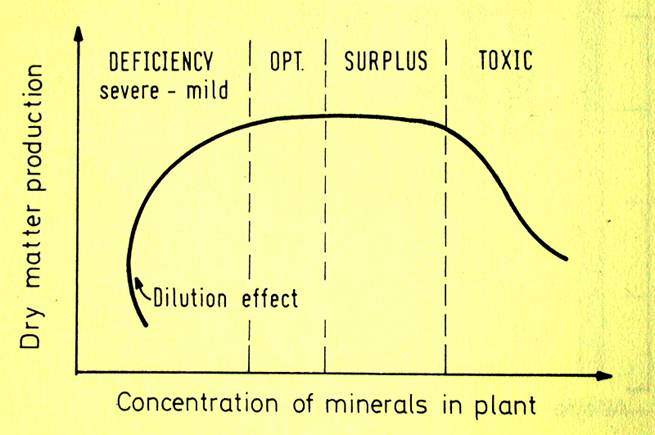
Connection between concentration of minerals in the plant and production of biomass
Basic principles of nutrient supply are of course valid also for the medicinal plant species and during their production we have to take them into consideration. According to the law of Justus Liebig described in 1840 the production of the plant is always determined by the factor which is in minimum level at the given time. This rule is valid for each environmental factor in a wider sense, too. In case of nutrients it means, that an optimal level of any mineral can not be used effectively by the organism if there is another one whose concentration is not enough for normal metabolism. It is useless for example to give the plant much potassium if there is a lack of iron in the soil. In the cultivation practice soil analysis may usually assure data about the absence or critical level of the target element. Short of extreme values, in general, the demand of plant species may be much different. Therefore it is a big problem that we have very few exact data for medicinal and aromatic plants and we could only relay on values of related species or on local experiences.
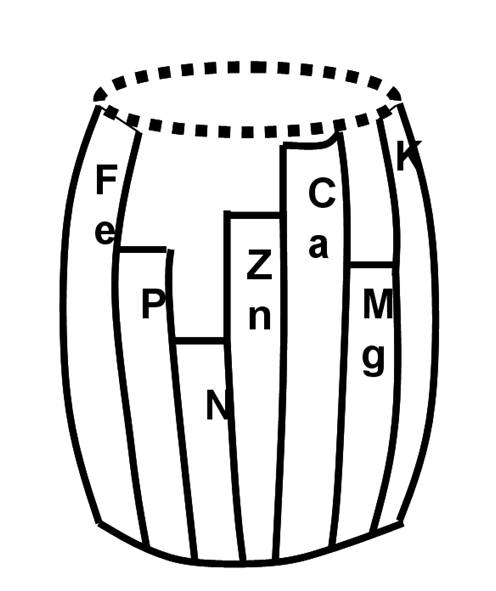
Model of the Liebig-Law
Another general principle has been described as law of Mitscherlich which used to be entitled as “Law of the decreasing yield growth”. According to this principle, the increasing dosages of fertilizers provide continuously smaller increase in yield even in case if any other agrotechnical factors are optimalized. With other words: the plant is less and less able to react on the continuously improving circumstances. In case of each variety (older or more intensive ones) the maximum plant response and by this way the best effective dosage of fertilizers may be different and for each variety a different optimum amount should be declared.
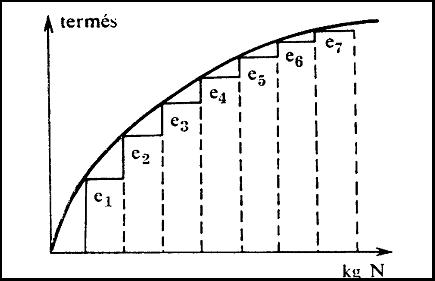
Establishment of the optimal dosage of each element for the plant can be carried out by several means. Chemical analysis of the harvested plant material supports data on the amount of nutrient which has been removed from the field. This amount is the Nutrient removal value (kg/ha). Calculating to unit yield, we get the value of the Specific Nutrient Content (kg/t). Unfortunately, unlike to cereals and other larger crops – in case of medicinal plant species there are few reliable data available. Most data exist on the species which are generally grown on large fields like cereals. Some experimental data have been summarized in tables abow. It shows that there are noticeable differences among species. Evaluating the levels of potassium we can see for example, that a relatively large amount of this element is removed from the soil by caraway, fennel, lemon balm while only low amount of that is taken away by horsetail or lovage. It can be observed, that species assuring fruit drugs seem to consume a higher level of phosphorous in the soil which is important to consider in agricultural practice.
Specific nutrient contents of some cultivated species of higher importance (kg/t fresh mass) (Hoppe, 2010)
|
Species |
Drug |
Nitrogen |
Phosphorous |
Potassium |
|
Angelica |
Root |
3,0 |
1,0 |
5,4 |
|
Basil |
Shots with leaves and flowers |
3,3 |
0,4 |
0,9 |
|
Pfeffermint |
Shots with leaves |
4,2 |
0,5 |
4,6 |
|
Lemon balm |
Shots with leaves |
4,9 |
0,6 |
6,3 |
|
Fennel |
Fruit |
27,8 |
5,5 |
12,6 |
|
Thyme |
Shots with leaves and flowers |
4,4 |
0,5 |
6,4 |
|
Chamomile |
Flowers |
4,2 |
0,9 |
4,5 |
|
Cone-flower |
Shots with leaves and flowers |
4,4 |
0,6 |
6,9 |
|
Cone-flower |
Root |
4,6 |
0,6 |
4,2 |
|
Caraway |
Fruit |
26,5 |
5,0 |
12,9 |
|
Marygold |
Flowers |
3,0 |
0,5 |
3,8 |
|
Lovage |
Root |
2,1 |
0,7 |
2,0 |
|
Lovage |
Shots with leaves |
3,7 |
0,5 |
1,1 |
|
Valerian |
Root |
2,9 |
0,8 |
1,9 |
|
Marjoram |
Shots with leaves and flowers |
4,8 |
0,6 |
4,9 |
|
Sage |
Shots with leaves |
4,9 |
0,5 |
5,1 |
Isotopic experiment provides the possibility to follow the movement of minerals in the plant body, their incorporation, excretion. This may help in determining the optimal dosage and form of fertilizers. Nevertheless, this method requires a sophisticated laboratory background, therefore its application is less frequent at the present practice.
Experiments with direct nutrient supply are closest to the everyday agricultural practice, both pot experiments or open field ones. One variation of pot experiment is the situation when the plants are grown in special solution of a single or some of the minerals. Another possibility is to check the behaviour of the plants in solutions which are lacking of certain or of some of the essential elements. However, as the soil in vivo is always a complex system of many factors, these pot experiments have restricted relevance on the practical situations. Open field small pot experiments have the drawback that in this complex soil system the results caused by individual elements can hardly be followed and interpreted because of their interactions and changing weather conditions.
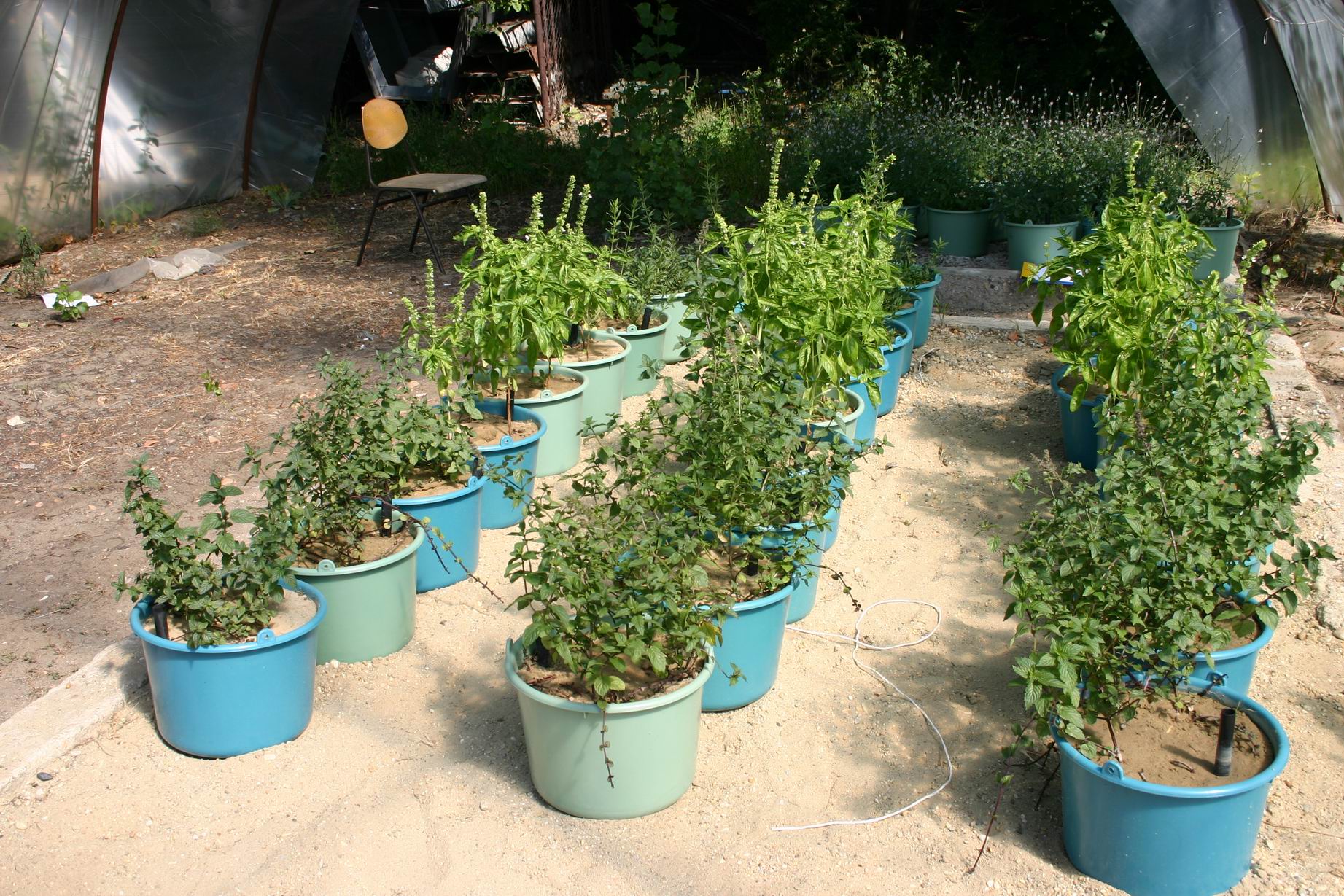
Pot experiment with peppermint and basil

Field experiment with spearmint
The necessary amount of a mineral in a given field can be determined by the following formula:
Nutrient need (kg/ha)= Need of the plant (a) + Correction due to soil (b) – Other corrections (c)
Need of the plant (a) can be calculated if the planned yield is multiplied by the specific nutrient content of the given species.
Correction factor due to soil (b) depends on the situation if the concentration of the target element in the soil is reaching the optimal value or not. If it is less, the correction factor is equal to the amount lacking to optimal refilling while if it is more than that, the surplus should be deduced from the plant need. The rate of optimal refilling is depending on the area, on the type of soil. These values are summarized in information tables. By soil analysis on our field we should establish whether the existing amounts are less or more than those of the optimal loading. Soil analysis should be carried out in specialized laboratories from 1-2 kg homogenous soil sample taken from the root sphere after harvesting the previous crop.
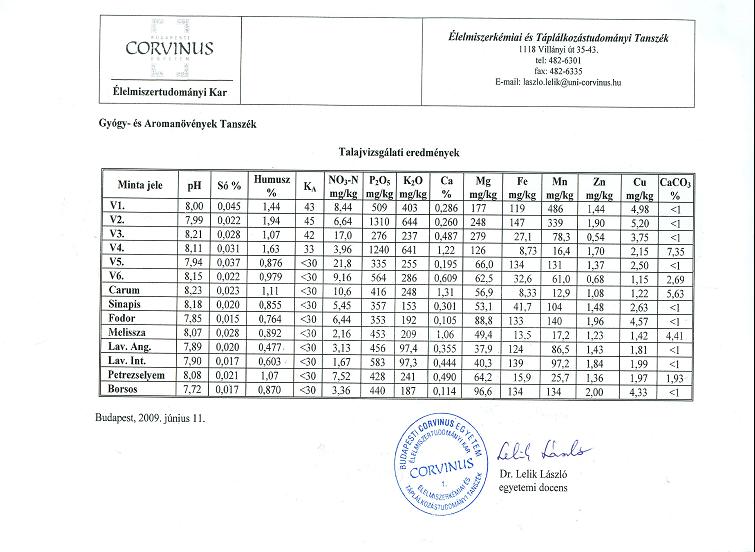
Results of a soil analysis
Other corrections (c) are needed for example in case of large dosage of manure or in case of pulses (Fabaceae) plants whose roots are in symbiosis with nitrogen fixing bacteria, etc.
Practically, in case of an optimal loading of the soil with minerals, the necessary dosage is equal with the need of the plant, so we only have to refill the amount which has been removed from the soil by the harvested crop. It is however, necessary, that we do not forget the soil being a complex system where the effect of nutrients is influenced not only by the optimal loading but also by several other factors like interaction of the elements, physico-chemical parameters of the soil and its living, microbiological constituents.
SORTS of fertilizers
Grouping of different sorts of fertilizers can be made according to several points of view.
Concerning their origin, we distinguish between organic and inorganic fertilizers. Organic fertilizers are of animal and/or plant origin like farmyard manure, poultry dung, turf-fecal. They have an advantage of not only enriching the soil by nutrients but at the same time improving its structure, water management and increasing its organic matter content and microbial flora.
Inorganic fertilizers are prepared from materials occurring in nature (nitrogen of the air, minerals of different kind) by chemical synthesis or transformation. They are simple (containing a single effective ingredient) or complex (containing more ingredients) fertilizers. These latter ones contain a wide spectrum of nutrients in majority of the cases, sometimes each of the most important ones is included. They have often both micro- and microelements as constituents which are present as chemical mixtures. On the other side, the mixed fertilizers are chemically speaking simple preparations but mixed physically. Sometimes the fertilizers are distinguished as micro- or macroelement containing ones.
Recently, plant conditioners are also available on the market. They contain most often both organic and inorganic constituents. As it can be seen from the name of the preparations, the goal of their application is primarily the improvement of the condition and tolerance of the plants, and is not directly intended for assuring nutrient supply. Although the presence and turnover of these preparations is quickly growing on the market, there is only a limited number of scientifically, experimentally verified data about their effects. Data especially on medicinal plants are practically missing. According to our investigation, the effect is rather dependent on the plant species, year and weather conditions. We have to remember the Law of Liebig: these preparations can not make any wonder under circumstances when basic requirements of the plant stand are not fulfilled.
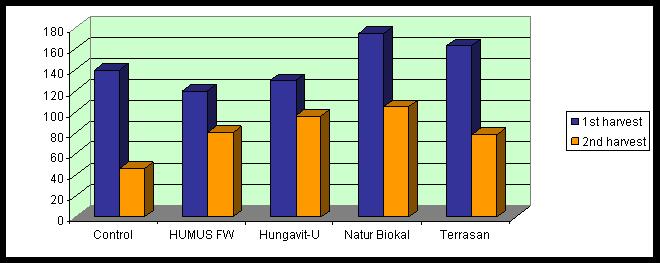
Shoot yield of basil during the first and the second harvest in different treatments by conditioners with untreated control
Fertilizers may be grouped according to their aggregate, too. Both organic and inorganic fertilizers may be administered as fluids or as solid substances, preparations: e.g. foliar fertilizers, liquid manure. Choosing the optimal formulation of fertilizer depends also on the fact whether we want to administer it through the soil or through the leaf surface. For this latter purpose only fluid fertilizers are appropriate.
For bringing out the fertilizers to the field, there are a lot of different machines and mechanical systems developed for this specific goal. Details of these mechanical solutions are not target of this training material, you can find it in Chapter Technical knowledge.
According to the time and goal of the nutrient supply we should distinguish the filling fertilization (carried out by large dosage before planting of perennial crops), starting fertilization (before sowing) and top-dressing (in vegetation period). The first two ones are intended to assure the basic nutrient requirements in the soil of the established culture. The top-dressing is applied mainly to refill the level of nutrients which have been extracted from the soil by the plants in the interest of their further optimal development.
Filling fertilization is not frequent in medicinal plant crops, applied mainly for species of longer lifetime and/or really high nutrient demand like lavender, sage, and peppermint. Starting fertilization is necessary and carried out almost always in autumn. Top-dressing is most important in medicinal plant cultures which provide herba drug and harvested several times a year. After each harvest a proper nutrient supply may assure re-growth of the plants. Examples for these are lemon balm or marjoram.
Specialities of fertilization of medicinal plant species
Nutrient need of medicinal plants
Approximately 50 species are produced regularly as field cultures in the Central European region. We have practical experiences back to several decades about their cultivation and nutrient supply. Tables are summarizing the basic information in connection with the most important species.
Basic data on nutrient supply of annual medicinal plants under Hungarian conditions
|
Name of species |
Organic manure (t/ha) |
Inorganic fertilizer |
|||||
|
Starting fertilization |
Top-dressing |
||||||
|
N |
P 2 O 5 |
K 2 O |
N |
P 2 O 5 |
K 2 O |
||
|
Anethum graveolens |
- |
80-100 |
(120) |
- |
140-160 |
- |
- |
|
Borago officinalis |
20-30 |
35-40 |
60-70 |
60-70 |
35-40 |
- |
- |
|
Calendula officinalis |
- |
40-60 |
60-80 |
80-100 |
40-60 |
- |
- |
|
Carthamus tinctorius |
- |
35-40 |
40-60 |
50-70 |
- |
- |
- |
|
Carum carvi f. annua |
- |
- |
50-70 |
50-80 |
50-70 |
- |
- |
|
Coriandrum sativum |
- |
60-80 |
60-80 |
40-50 |
20-25 |
- |
- |
|
Digitalis lanata |
- |
70-100 |
120-160 |
100-150 |
70-100 |
- |
- |
|
Linum usitatissimum |
- |
25-40 |
60-70 |
60-70 |
- |
- |
- |
|
Majoranna hortensis |
- |
50-60 |
60-80 |
120-140 |
100-120 |
20-25 |
- |
|
Matricaria recutita |
- |
- |
40-60 |
- |
10-40 |
60-70 |
50-70 |
|
Ocimum basilicum |
20-30 |
35-40 |
50-70 |
60-80 |
70-90 |
- |
- |
|
Papaver somniferum |
- |
35-40 |
50-70 |
50-70 |
20-30 |
- |
- |
|
Pimpinella anisum |
- |
40-60 |
40-60 |
60-90 |
20-30 |
- |
- |
|
Satureja hortensis |
- |
- |
60-80 |
50-60 |
50-80 |
- |
- |
|
Silybum marianum |
- |
25-30 |
80-100 |
40-50 |
- |
- |
- |
|
Sinapis alba |
- |
80-150 |
80-100 |
30-40 |
- |
- |
- |
|
Valeriana officinalis |
150-200 |
(30-40) |
(20-30) |
(40-50) |
40-50 |
- |
- |
Basic data on nutrient supply of perennial medicinal plants under Hungarian conditions
|
Name of species |
Organic manure (t/ha) |
Inorganic fertilizer |
||||||||
|
Starting |
After planting |
In further years |
||||||||
|
N |
P 2 O 5 |
K 2 O |
N |
P 2 O 5 |
K 2 O |
N |
P 2 O 5 |
K 2 O |
||
|
Foeniculum vulgare |
- |
- |
80-100 |
40-60 |
20-40 |
- |
- |
20-40 |
40-60 |
30-40 |
|
Hyssopus officinalis |
- |
- |
60-80 |
60-70 |
40-50 |
- |
- |
60-90 |
- |
- |
|
Lavandula angustifolia |
30-50 |
- |
70-80 |
80-120 |
70-80 |
- |
- |
60-100 |
50-60 |
80-120 |
|
Levisticum officinale |
20-30 |
60-70 |
100-120 |
140-150 |
50-60 |
70-80 |
60-80 |
50-60 |
70-80 |
60-80 |
|
Melissa officinalis |
25-30 |
- |
- |
- |
40-60 |
50-60 |
70-80 |
70-90 |
50-60 |
70-80 |
|
Mentha piperita |
20-30 |
- |
- |
- |
90-150 |
60-90 |
50-80 |
90-150 |
60-90 |
50-80 |
|
Salvia officinalis |
20-30 |
- |
60-80 |
40-60 |
30-40 |
30-60 |
30-40 |
30-40 |
30-40 |
30-40 |
|
Thymus vulgaris |
20-30 |
- |
- |
30-40 |
30-40 |
30-40 |
30-40 |
30-40 |
30-40 |
30-40 |
It is a widespread but not valid belief that medicinal plants in general are not demanding, their cultivation is simple, and it does not need large investments. The mentioned production experiences show that only approximately one quarter of the cultivated medicinal plant species has really low nutrient demand and can be appropriately produced also with low fertilizer dosages or on soils of poor nutrient content (e.g. white mustard, sage, and chamomile). Another quarter of the species spectrum includes the plants of moderate nutrient demand. Cultivation of these species can not be carried out without nutrient supply but the requirements are not high and include mainly major nutrients. Such species are e.g. savory, thyme or dill. A next 25% of the widely cultivated medicinal plants can be characterised by a moderately high nutrient demand. In these cases both starting fertilization and top dressing seem to be necessary and the optimum dosages are rather high. Species like oil pumpkin, coriander, and coneflower belong here, among others. As the last one we should mention the species which have a definitely high demand for nutrients and therefore fertilization has a major role in their cultivation. Without regular and high nutrient supply their yield is not economically acceptable, however, accordingly, the costs are also high. Mint species, basil, poppy, etc belong here. Obviously, this grouping of medicinal plant species provides only approximate information about their nutrient demand, the exact dosages and fertilization technology depends on the exact species and characteristics of the habitat. Unfortunately, we could lay down, that farmers of medicinal plant crops are often operating according to their own experiences.
A frequent opinion seems to be that areas of unfavourable natural circumstances can be advantageously utilized by cultivation of medicinal plants. As a whole, this statement is not valid, of course. At the same time, it is true that there are some species known which exhibit an elevated tolerance against suboptimal features of the soil. Chamomile, yarrow, pyrethrum and some Artemisia species have a high tolerance against the high salt (NaCl) concentration of the soil. Their natural populations are frequently found on salty areas. However, we have to be aware of the fact that this phenomenon does not mean that these species really need the high salt concentration of the soil. Tolerance against salt is based on the strong osmotic potential of the roots of these plants and therefore they are able to take up and accumulate the salts in their tissues. Nevertheless, a better development of these species has been observed in stress-free environment, without high soil salt concentration.
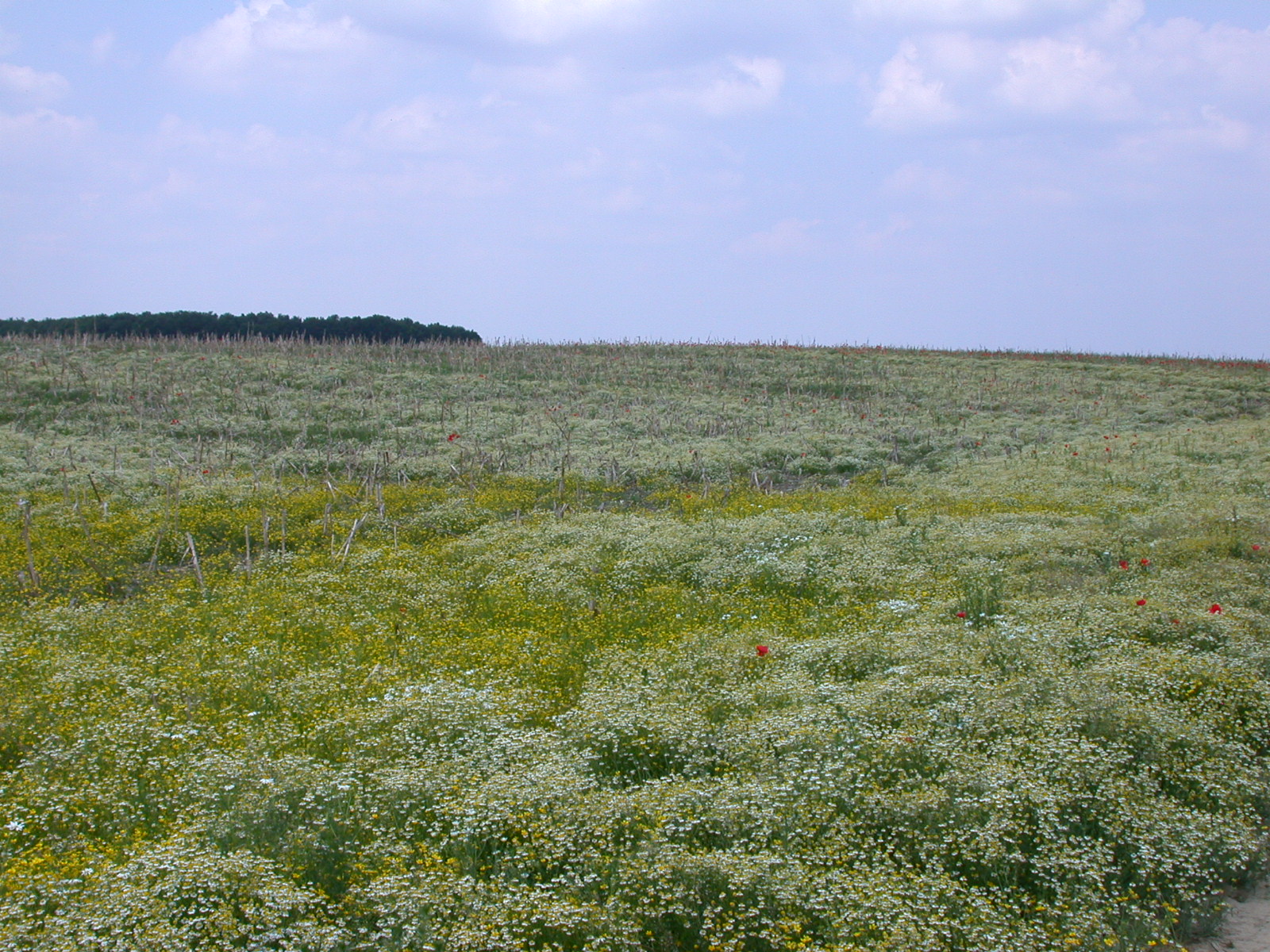
Chamomile growing abundantly in the salty soils of Hortobágy area in Hungary
The utilization of areas with thin, stony and calcareous soils can be fulfilled by the cultivation of some medicinal and aromatic plants. The most well known ones for this purpose are oregano, lavender species and sage. In case of a careful plantation process, these crops may provide a long term production even under these circumstances, as the original habitat of them is similar to the mentioned ones. Under poor conditions however, outranging yield and/or high income can not be anticipated.
As special characteristics of some medicinal plant species we should mention the symbiosis with nitrogen fixing bacteria. This behaviour enables a sustainable cultivation even with poor nitrogen supply and provides an advantageous previous crop for the next one. Such species are e.g. fenugreek, liquorice or sanddorn.
Nutrient responses of medicinal plants
We can influence several plant characteristics by supply of different nutrients, minerals; this is of course valid both for medicinal plants and any other crop. Therefore it is highly important and at the same time very difficult to optimize and take each factor into consideration.
In the simplest case the farmers prefer a high biomass or drug yield. A well designed fertilization may result in a significant increase of these yields in most cases. As the example of the formerly less studied species, spearmint (Mentha spicata var. crispata) shows, that an additional application of potassium being in minimum in the soil was able to assure the growth of yields. Besides an appropriate content of the soil with nitrogen and phosphorous, submission of 200 kg/ha potassium resulted in 25% excess yield of the shoot, however, higher ratios may have already a retarding effect. Data of the four year experiment also show that factors being in minimum quantity may have a big influence on the biomass under the given circumstances. In a year of high precipitation (2010) even the 300 kg/ha dosages could be well utilized by the plant.
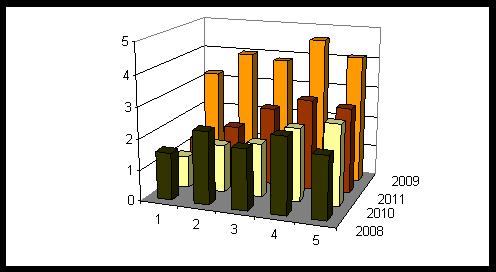
Shoot yield of spearmint in different nutrient treatments: 1.untreated, 2. N+P, 3.N+P+K100kg/ha, 4. N+P+K200kg/ha, 5. N+P+K300kg/ha
This statement can be confirmed also by the following two examples. A caraway stand in soil poor of nitrogen was not able to utilize even the highest amounts of potassium. In another soil of chernozem type rich in each elements any additional fertilization had a retarding effect on the yields. This was due to the excess quantities of nutrients.
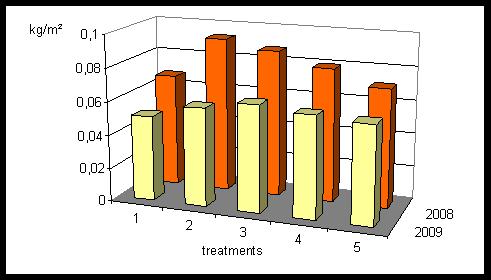
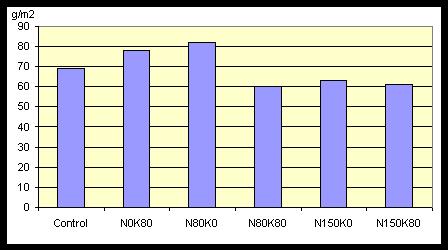
Yield of caraway in different fertilization treatments (Szarvas)
A similar experience has been described in two German habitats. While fertilizing a fennel (Foeniculum vulgare) plantation by different macroemelents resulted in improved yield in Aschersleben according to optimum function, the same treatments were not able to assure any surplus in the field of Weissenfels. This latter area has namely a much higher nutrient content of the soil, practically saturated by the target minerals. These results also demonstrate the fact mentioned in Chapter 5.1. about the importance of correction factor according to the soil nutrient content during calculating the optimal dosages of fertilizers. In a soil appropriately supplied by the necessary elements, fertilization may retard plant growth, decrease the profitability of the production and cause an environmental load.
Effect of increasing dosages of N, P and K fertilizers on the yields of fennel in two German habitats (through Müllenberg, 1966)
|
Dosage of fertilizers (kg/ha) |
Yield, t/ha |
|
|
Aschersleben |
Weissenfels |
|
|
N 0 |
0,71 |
1,58 |
|
N 20 |
0,71 |
1,56 |
|
N 40 |
1,08 |
1,52 |
|
N 60 |
1,07 |
1,50 |
|
P 0 |
0,84 |
1,58 |
|
P 20 |
0,92 |
1,56 |
|
P 40 |
1,08 |
1,52 |
|
P 60 |
1,07 |
1,63 |
|
K 0 |
1,09 |
1,51 |
|
K 20 |
1,14 |
1,68 |
|
K 40 |
1,08 |
1,52 |
|
K 60 |
0,89 |
1,55 |
In case of medicinal plants the general law that the emergence of any nutrients should be influenced by the presence and rate of the other ones is also valid. Findings during the introduction experiments of nightshade (Atropa belladonna) would well demonstrate it. It has been proved that the effect of potassium (K) macroelement is strongly depending on the available concentrations of the microelement manganese (Mn).
Effect of potassium and manganese treatments on the height and herbage yield of nightshade (through Mohammad et al ., 2011)
|
Rates of fertilizer |
Plant height (cm) |
Herbage yield (g/plant) |
|
K 0 Mn 0 |
137 |
58 |
|
K 0 Mn 1 |
154 |
66 |
|
K 0 Mn 2 |
149 |
71 |
|
K 1 Mn 1 |
157 |
86 |
|
K 1 Mn 2 |
154 |
92 |
|
K 2 Mn 1 |
165 |
95 |
|
K 2 Mn 2 |
163 |
99 |
There are several plant characteristics influencing the harvestable yield indirectly and many of them may be affected by the nutrient supply. There are some useful examples even in case of medicinal plant species for this phenomenon.
Unit yield of white mustard is strongly influenced by the density of the plant stand, by the individual yield potential but also by the size of the developed seeds (defined usually as thousand seed mass). Although mustard does not have a specifically high demand for nutrients, an additional fertilization may manifest itself in increased seed size (unit mass). This reaction is however, characterised by an optimum function as observable in the figure.
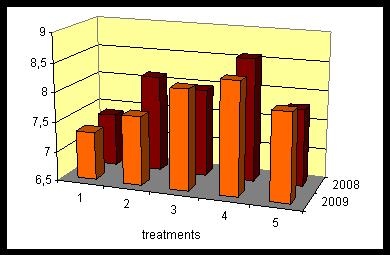
Thousand seed mass of white mustard (g) in different fertilization treatments: 1.Control, 2. N+P, 3. N+P+K,50kg/ha, 4. N+P+K100 kg/ha, 5. N+P+K150kg/ha
Nutrients also frequently influence the dynamics of plant development, the ontogenesis. They have a role in transition processes from the vegetative to the generative phase, in development of flowers but also in fertilization and accelerating ripening, too. In caraway plots additional supply with potassium and magnesium resulted in an earlier and more uniform flower formation. This process leads to an earlier, uniform ripening, better harvesting and higher yields.
However, we must not forget the possible negative effects, either. The phenomenon that an overdosage of nitrogen may result in elevated height and weaker stems causing a lay down of the crop. This may happen in cycle of our species, too, like in case of poppy, fennel, mustard, etc. As a consequence of the better nutrient supply the herbage yield of spearmint was increased, as mentioned above. At the same time however, a decrease in the size of the leaves could be observed. The largest leaves were achieved by the smallest potassium dosages. A potassium rate above the 100 kg/ha dosage had a negative influence on leaf size, obviously as consequence of the higher yield. In a higher plant stand of longer stems, many leaves and high biomass, there is namely no place and reduced light for the individual leaves. As the leaf drug (folium) has frequently a priority on the market and a usually higher price than the shoot drug (herba), this phenomenon should be of importance for the practice.
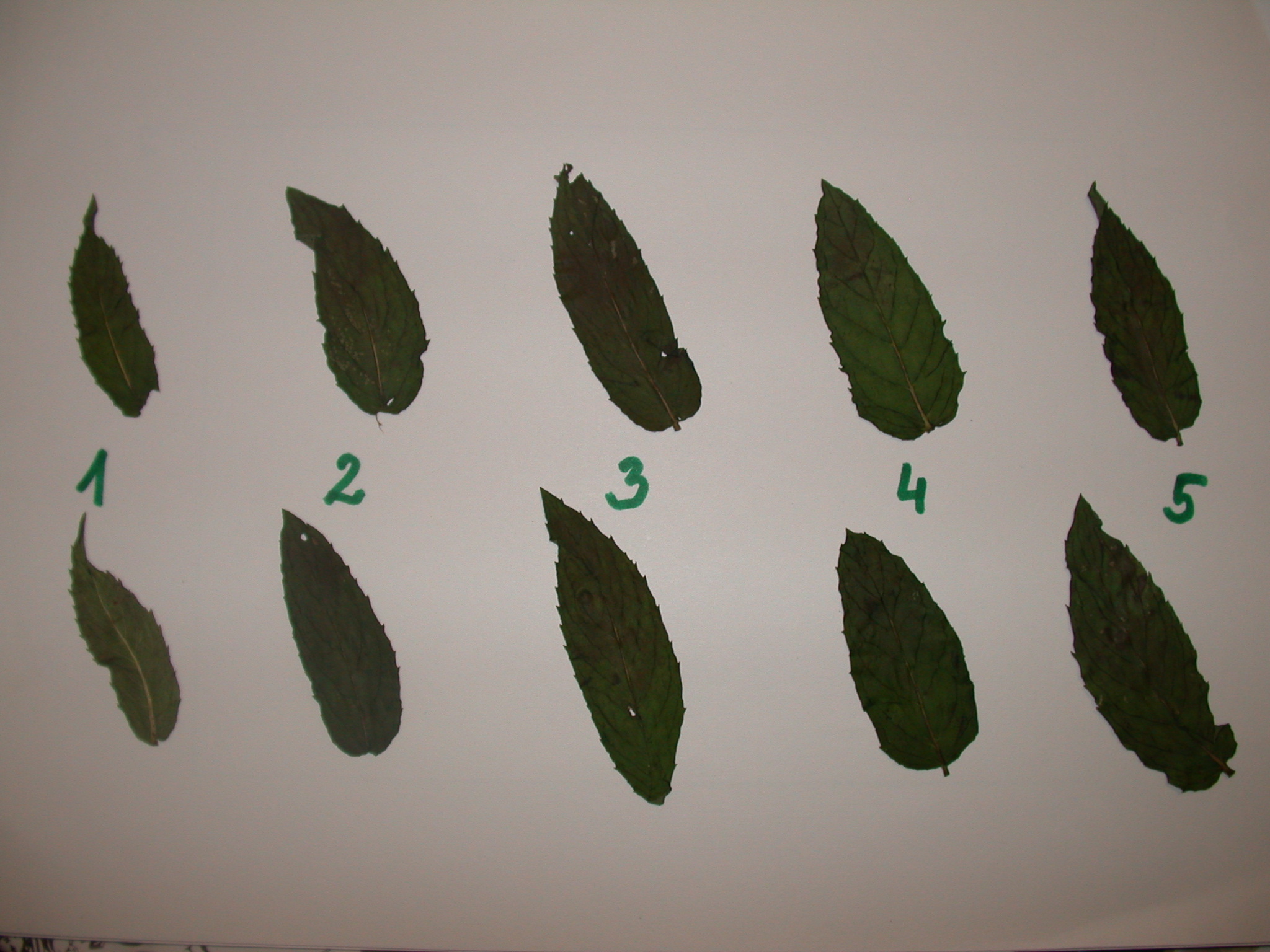
Size of leaves of spearmint due to different nutrient supply Treatments: 1=0; 2=NP; 3=NPK100kg/ha; 4=NPK200kg/ha; 5=NPK300kg/ha
A balanced nutrient supply and especially higher potassium fertilization may contribute to stress tolerance of different species like tolerance against drought, diseases. In lavender stand we also found an increased frost tolerance in plots supplied by different fertilizers. A treatment by complex nitrogen, phosphorous but especially by potassium fertilizer increased winter resistance of the plants. In this latest case the number of frost damaged plants was reduced by one third compared to the non-treated plots. It seems, that in young stands of this species of Mediterranean origin, a proper and well designed, balanced nutrient supply may be of high importance, even if this species usually known as less nutrient demanding one. Increasing frost tolerance may have a big significance especially in loose, sandy soil.
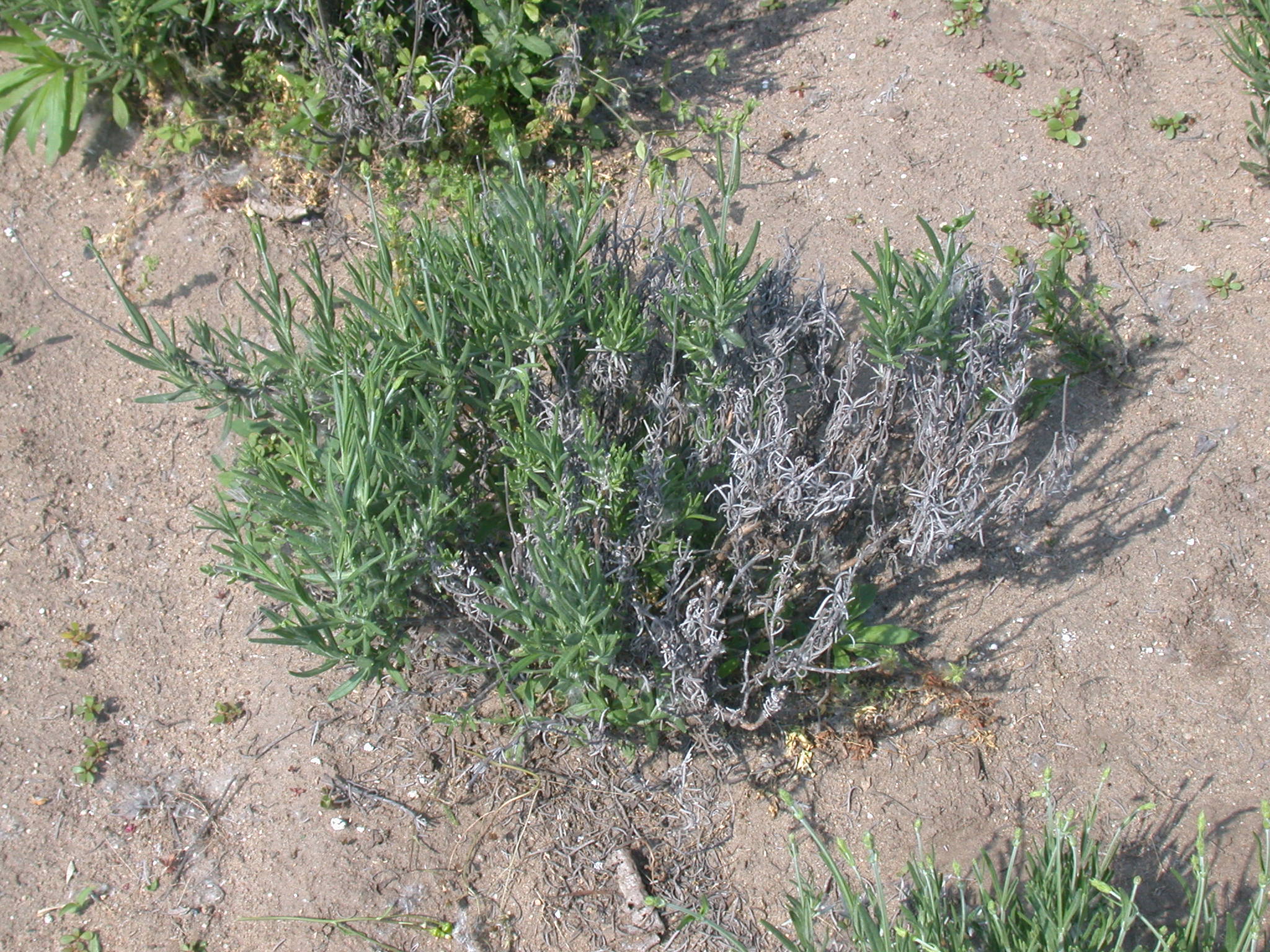
French lavender damaged by winter frosts
In production of medicinal and aromatic plants we usually cultivate species and only in exceptional cases one is dealing with selected varieties. Therefore we have only a limited knowledge about the differences of genotypes, varieties of the same species concerning their nutrient requirements and responses. It is well known from the circle of field crops or vegetables that there are considerable differences between the fertilization technologies of intensive and extensive varieties. In case of medicinal plants there is hardly any information regarding this aspect, but obviously we have to take it into consideration. As example, let’s mention here the findings with nettle (Urtica dioica) during the introduction experiments into the agriculture. Although nettle is usually considered to have high nitrogen preference, it was proven that there are some genotypes of lower nitrogen requirement, too. Based on practical experiences we can state, those poppy varieties of longer vegetation period need more nutrients, especially nitrogen than varieties ripening earlier (even by 2-3 weeks). Nitrogen supply in spring might contribute also to a better start of growth and strengthening of the overwintered plantlets of winter poppy varieties.
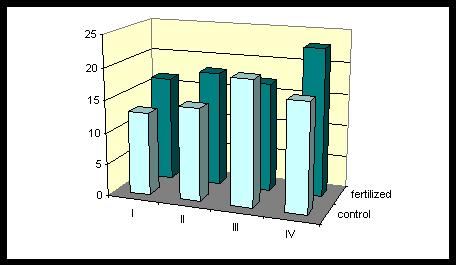
Response of different nettle accessions to nitrogen treatment
Connection between nutrient supply and production of active ingredients
A special goal of medicinal plant production is reaching maximum amounts of active ingredients. Yield of active ingredients is determined by the biomass and by the concentration of active compounds in the plant mass. While the general rules of biomass production in plant cultivation can be applied also for medicinal plants, the picture is more specific in case of active molecules. Accumulation of biologically active compounds depends on their chemical nature (essential oil, glycoside, alkaloid, etc.), on the site of biosynthesis (root, leaf, fruit, etc.), on the method and place of transfer, on the site of accumulation in the tissues and cells (duct, bubble, gland, etc.). The processes are influenced by several interactions which are hard to follow and detect by experimental way, as it was shown by several research results.
Basically we can conclude that accumulation of active materials is principally indirectly influenced by the nutrient supply: by modifying ontogenetic processes, developmental dynamics, proportion of organs, constitution of tissue structure, etc. As the majority of active compounds are produced in the secondary metabolic processes, they are basically determined by the primary biosynthetic routes.
Experiences show three characteristic features of the yield of active materials as products of plant biomass and active material concentration values.
a./ Linear connection model describes the phenomenon when biomass is proportionally growing as result of increasing nutrient supply while accumulation level of active materials is practically stable. In consequence of this, active material yield changes parallel with the growth of biomass. This is the case e.g. for the alkaloid production of Solanum species or for the essential oil production of Mentha arvensis.
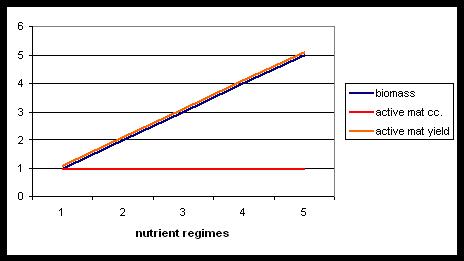
Linear model of nutrient supply and yield of active ingredients
b./ According to a power function model both biomass and level of active materials are growing due to the increasing nutrient dosages, although the dynamics of them is not necessarily the same. As consequence of this, however, the yield of active ingredients is growing too, by an even stronger dynamics than the other two. This has been found e.g. in experiments with hairy foxglove for the production of lanatoside C glycoside.

Power model of nutrient supply and yield of active ingredients
c./ A polynomial model describes the connection which is characterised by a continuous growth of biomass due to the increasing fertilizer rates, however, the level (concentration) of active materials does not show any well defined connection with the nutrient supply. As a consequence of it, the result of these two is a hardly predictable, “irregular” value. This was found e.g for the essential oil production of dill and valerian.
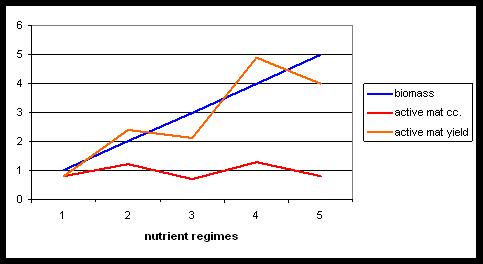
Polynom model of nutrient supply and yield of active ingredients
It should be emphasized, that each of the above mentioned reactions is limited by the saturation point, thus, they are valid only till a certain amounts of nutrients. After saturation, toxic and adverse reactions are starting. The effect of nutrient supply can only be evaluated individually for each species compared to its optimum function and values.
It is obvious, that the statement that medicinal plants tend to produce higher levels of active ingredients if they are living under unfavourable conditions, is false. Although it is true that certain active compounds might be produced at higher quantities under stress conditions –like essential oil components, phenolics, etc.- but their size and the parallel experienced decrease in biomass does not seem to be an optimal alternative. It is much more justified that the highest and most profitable yield of active compounds may be assured by an optimal plant development and balance of vegetative growth and generative organs of medicinal species. It is shown in the example below: the larger the spacing of caraway is, the better the accumulation levels of total essential oil is. At the same time and carvone content is higher, too.
Active ingredients of dill in different growth areas
|
Row distance (cm) |
Plant distance |
Essential oil content (d.w.%) |
Carvone content (d.w.%) |
|
30 |
Dense |
4,89 |
2,52 |
|
30 |
Thin |
5,14 |
2,67 |
|
60 |
Dense |
5,03 |
2,67 |
|
60 |
Thin |
5,44 |
2,88 |
Nutrient supply and the composition of active ingredients
Considering the quality of the drugs there is usually a difference also between content of active ingredients and their composition (proportion of individual chemical compounds). It is not the same for example if we speak about the accumulation level, the content of essential oil in peppermint leaves or about their menthol content which is one major component besides many other ones in the oil. Similarly, the total alkaloid content of poppy capsules is a single parameter of the drug quality and the ratio of morphine or thebaine in it is usually even more important. As it has already been mentioned, biosynthetic pathways of secondary compounds are in close connection with the formation of the primary compounds. If there is a continuous precursor flow from this primary biosynthetic routes, generally the assimilate formation of secondary compounds may be undisturbed. However, the types of special compounds formed (e.g. morphine, menthol, apigenin, etc.) are highly depending on the presence and activity of enzymes and enzyme complexes involved in these synthesis. The enzymatic background is directed by the genetic constitution, inheritance. It has been proven that a poor development of the plant due to the shortage of nutrients results in disturbance of the essential oil accumulation of peppermint – as formation of terpenoids seems to be an energy-demanding process. At the same time, the proportions of the main components menthol and menthon in the oil are much more stable traits, regulated primarily genetically and manifested through the enzymatic changes during ontogenesis. Thus, a variety of peppermint capable for a higher menthol accumulation will produce higher rates of menthol in any nutrient supply circumstances than a variety which is genetically less determined in this direction. It has been shown also in experiments with chamomile: the number of flowers responded like an optimum power to increasing nitrogen dosages, while the proportion of chamazulene practically did not show any change under the same circumstances. In the same experiment, increasing levels of phosphorous fertilizer induced both an increasing flower number and an increased mass of individual flowers, however hardly any change in chamazulene ratio.
A connection between the chemical nature of active compounds and their response to changing nutrient levels may be presumed, too. Polysaccharides, mucilages which accumulate usually as storage compounds are produced at an elevated level above the current need if the plant has an appropriate nutrient supply. Similarly, more fatty oils and fatty acids are produced under these circumstances as they are devoted to assure the development of the germinating seeds and seedlings. In some filed crops like sunflower, it has been observed that administration of potassium fertilizers improved the quality of the oil by increasing the proportion of unsaturated fatty acids. Although we have practically no reliable data about the connection of fatty oil accumulation and the nutrient supply of the medicinal plant species, but in generally it is true that the plant develops larger seeds (fruits) with proportionally (to a certain level) larger concentration of fatty acids. However, interactions may be present also in these cases: abundant growth may induce not only bigger but also more seeds which in return might reduce the individual seed size (thousand seed mass).
Profitability of nutrient supply in medicinal plant production
Based on the Law of Mitscherlich, the surplus of the yield is able to cover the excess costs of the fertilization only to a certain dosage, after this point the additional nutrient supply results in deficit.
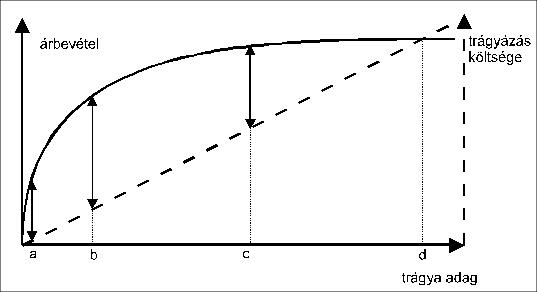
In the production of medicinal plants, fertilization does not mean the biggest costs of the cultivation. Expenses of fertilization are usually negligible beside the costs of manual weed control and drying of the harvested material. However, as it has been demonstrated in this chapter, nutrient supply may influence practically a big row of plant characteristics and as such, may have a great influence on the profitability of the whole production.
Primarily we have to calculate the nutrient need of the plant stand (see chapter 5.1.). Nevertheless, the lack of data on the need of the given medicinal plant species may cause a basic obstacle. There are not any known differences between intraspecific taxa, varieties. In these cases it seems to be necessary to take the practical cultivation experiences into consideration. Dosages of fertilizers should be handled however, by care and to treat them as precedents which may be always influenced by the exact circumstances (soil type, precipitation, irrigation, previous crop) of the production field.
Quantity and quality of the produced drugs can not always be optimized at the same time either, as it has been shown. The need of the buyer should be considered first of all, as in some cases only the mass of the product is important but in many other situations parameters like colour, size, and active material content are also significant factors determining the price. Recently, purchase of the drug -especially in pharmaceutical raw materials- is practically impossible below a standardized level of defined ingredients.
Control questions:
(More answers are possible!)
Right answers
References:
Bernáth, J. (szerk.): Vadon termő és termesztett gyógynövények, Mezőgazda kiadó, Bp. p. 348-349.
Bernáth, J. (1999): A gyógy- és illóolajos növényfajok tápanyagellátása. In: Füleki, Gy. (szerk.) Mezőgazda Kiadó, Budapest, p. 403-427.
Bernáth, J. - Németh, É. (2004): A hazai gyógy- és aromanövény spektrum elemzése ökológiai sajátosságaik alapján. Agro 21 füzetek, 34: 79-95.
Bernáth J.- Németh É. (szerk.) (2007): Gyógy-és fűszernövények gyűjtése, termesztése és felhasználása. BSc tankönyv. Mezőgazda Kiadó, Budapest. pp. 256.
Gosztola, B.- Sárosi, Sz.- Németh, É. (2010): Variability of the essential oil content and composition of chamomile (Matricaria recutita L.) affected by weather conditions, Natural Product Communications 5 (3) 465-470.
Hoppe, B. (szerk.), (2010): Handbuch des Arznei- und Gewürzpflanzenbaus, Band 2. Grundlagen des Arznei- und Gewürzpflanzenbaus. Bernburg: Saluplanta eV., pp. 484.
Kádár, I.- Földesi, D. (2002): A mustár műtrágyázása csernozjom talajon. Növénytermelés, 51 (4), 437-447.
Mohammad, A. S.O.- El-Hiti, S.M.J.- Rezazadeh, Sh.- Yekta, M. (2011): Effect of potassium with or without micronutrients on plant growth and alkaloid content in deadly nightshade (Atropa bella-donna L.), Z. Arznei- und Gewürzpflanzen, 16 (2): 70-74.
Németh, É.-Bernáth, J. (2004): Az évjárat és a környezeti változások hatásai a gyógy- és aromanövények produkciójára. Agro 21 füzetek, 34: 96-107
Németh, É.- Szabó, K.- Rajhárt, P.- Popp, T. (2012): Die Wirkung der Kaliumversorgung auf die Produktion und Drogenqualität von Minzen. Z. Arznei- und Gewürzpflanzen, (in press)
Németh, -E. Varga, -R. Franke (2001): Variabilität des ätherischen Ölgehaltes und deren Ursachen in Hyssopus officinalis L. Z. für Arznei-und Gewürzpflanzen, 6, (1): 29-34.
Z. Németh É.- Rajhárt P.- Szabó K.- Antal T. (2010): A tápanyag-utánpótlás hatása gyógynövények hozamára és drogminőségére. Kertgazdaság, 42 (3-4): 128-135.

